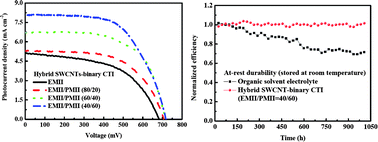All-solid-state dye-sensitized solar cells incorporating SWCNTs and crystal growthinhibitor†
Abstract
A solid organic ionic crystal,

* Corresponding authors
a
Department of Chemical Engineering, National Taiwan University, No. 1, Sec. 4, Roosevelt Road, Taipei, Taiwan
E-mail:
kcho@ntu.edu.tw
Fax: +886-2-23623040
Tel: +886-2-23660739
b Institute of Polymer Science and Engineering, National Taiwan University, No. 1, Sec. 4, Roosevelt Road, Taipei, Taiwan
A solid organic ionic crystal,

 Please wait while we load your content...
Something went wrong. Try again?
Please wait while we load your content...
Something went wrong. Try again?
C. Lee, L. Lin, P. Chen, R. Vittal and K. Ho, J. Mater. Chem., 2010, 20, 3619 DOI: 10.1039/B925221E
To request permission to reproduce material from this article, please go to the Copyright Clearance Center request page.
If you are an author contributing to an RSC publication, you do not need to request permission provided correct acknowledgement is given.
If you are the author of this article, you do not need to request permission to reproduce figures and diagrams provided correct acknowledgement is given. If you want to reproduce the whole article in a third-party publication (excluding your thesis/dissertation for which permission is not required) please go to the Copyright Clearance Center request page.
Read more about how to correctly acknowledge RSC content.
 Fetching data from CrossRef.
Fetching data from CrossRef.
This may take some time to load.
Loading related content
